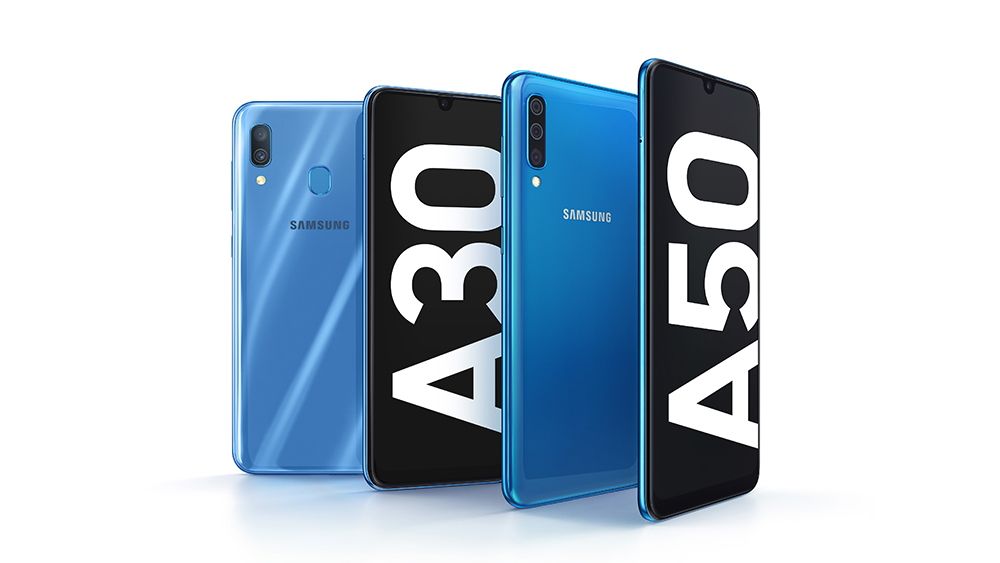For years, Samsung's budget Galaxy J series and mid-range Galaxy A series were known for failing to compete against the competition in terms of specifications and value. The impact has been tangible: Samsung has been decisively overtaken by Xiaomi in the Indian smartphone market, and the company is continuing to lose market share as competitors release better phones at the same price points. Samsung's response to this was started by the the launch of the Samsung Galaxy M10 and Galaxy M20, which represented a significant turnaround in terms of the overall direction. The Galaxy M30 is also due to launch in India in two days time. In the meantime, Samsung has officially announced the mid-range Galaxy A50 and the Galaxy A30 at Mobile World Congress - continuing its march back to relevancy in the mid-range segment.
The entry-level Galaxy A10 is still waiting for its own announcement. The Samsung Galaxy A50 and the Galaxy A30 are meant to be a new generation of Galaxy A series phones. Both phones have Infinity-U displays, which is Samsung's term for the waterdrop notch. The Galaxy A50 has an in-display fingerprint sensor (an optical one, presumably), while the Galaxy A30 has a rear fingerprint sensor. Both phones have displays of the same type, but their specifications differ in terms of SoC, RAM and storage configurations, front camera specification, and rear camera specifications. Both phones have a "3D Glasstic" design which seems to consist of a plastic frame and a glass (?) back.
The specifications of both phones are noted in the table below:
|
Specification |
Samsung Galaxy A30 |
Samsung Galaxy A50 |
|---|---|---|
|
Design |
3D Glasstic |
3D Glasstic |
|
Colors |
Black, White, Blue |
Black, White, Blue, Coral |
|
Display |
6.4-inch; FHD+ 1080 x 2340, 19.5:9, Super AMOLED |
6.4-inch; FHD+ 1080 x 2340, 19.5:9, Super AMOLED |
|
Infinity Display |
Infinity-U |
Infinity-U |
|
Dimensions |
158.5 x 74.7 x 7.7 mm |
158.5 x 74.7 x 7.7 mm |
|
SoC |
Exynos 79042x Arm Cortex-A73 cores @ 1.8GHz + 6x Arm Cortex-A53 cores 1.6GHz |
Exynos 96104x Arm Cortex-A73 cores @ 2.3GHz + 4x Arm Cortex-A53 cores @ 1.7GHz |
|
RAM and Storage |
3GB + 32GB;4GB + 64GB |
4GB + 64GB;6GB + 128GB |
|
Expandable Storage |
Up to 512GB |
Up to 512GB |
|
USB |
Type-C |
Type-C |
|
Battery and Charging |
4,000 mAh15W Fast Charging |
4,000 mAh15W Fast Charging |
|
Fingerprint Sensor |
Rear |
On-screen |
|
Rear Camera |
16MP, f/1.7 +5MP, f/2.2, ultra wide |
25MP, f/1.7 +5MP, f/2.2, fixed focus for depth sensing +8MP, f/2.4, ultra wide, fixed focus |
|
Front Camera |
16MP, f/2.0, fixed focus |
25MP, f/2.0, fixed focus |
Both phones feature Samsung Health, Samsung Pay, Bixby Home, and Bixby Reminder. The Galaxy A50 also features Bixby Voice and Bixby Vision (both features are lacking on the Galaxy A30).
The Galaxy A50 is also notable for featuring a triple camera setup. It's not the first Galaxy A series phone to feature such a setup, as Samsung had launched the Galaxy A7 with triple cameras and the Galaxy A9 with quad cameras in late 2018. The Galaxy A50 has an "intelligent switch" feature in its camera which enables it to identify and recommend when to use the Wide Shot mode.
The 25MP primary camera of the Galaxy A50 offers a Live Focus feature thanks to the 5MP depth sensor. It also has AI Camera to help users capture the best scene, including a Scene Optimizer feature to recognize and optimize 20 scenes. Flaw Detection---first featured in the Samsung Galaxy Note 9---also makes its way to the Galaxy A50. Bixby Vision acts as a Google Lens competitor, although it has generally been recognized to be an inferior product.
The front camera also has a Selfie Focus feature for background blur. The on-screen fingerprint should not be taken to be similar to that of the Galaxy S10's in-display sensor, because both are powered by fundamentally different technologies (optical vs. ultrasonic).
Both the Galaxy A50 and the Galaxy A30 are powered by 4,000mAh batteries, which is a serious upgrade over past Galaxy A series phones. Both phones also feature 15W fast charging. In terms of biometrics, both phones also have support for Samsung's software-based face unlock.
The Galaxy A30's downgrades deal with the processor (Exynos 7904 vs. Exynos 9610), RAM (3GB/4GB vs. 4GB/6GB), storage (32GB/64GB vs. 64GB/128GB), front camera (16MP vs. 25MP), and rear camera specifications. The Galaxy A30 drops the depth sensor, and chooses to go with a lower resolution 5MP ultra wide camera. The primary camera's resolution is also reduced from 25MP to 16MP.
The Galaxy A30's Exynos 7904 SoC is intended to compete with the Qualcomm Snapdragon 636, while the Galaxy A50's Exynos 9610 competes with the Qualcomm Snapdragon 660. Unfortunately, Samsung LSI continues to lack a competitor to newer SoCs such as the Qualcomm Snapdragon 675.
Samsung hasn't revealed pricing and availability details of the Galaxy A50 and the Galaxy A30 yet. The phones will likely launch in India and other international markets soon, at which point the pricing details should be known to us.

